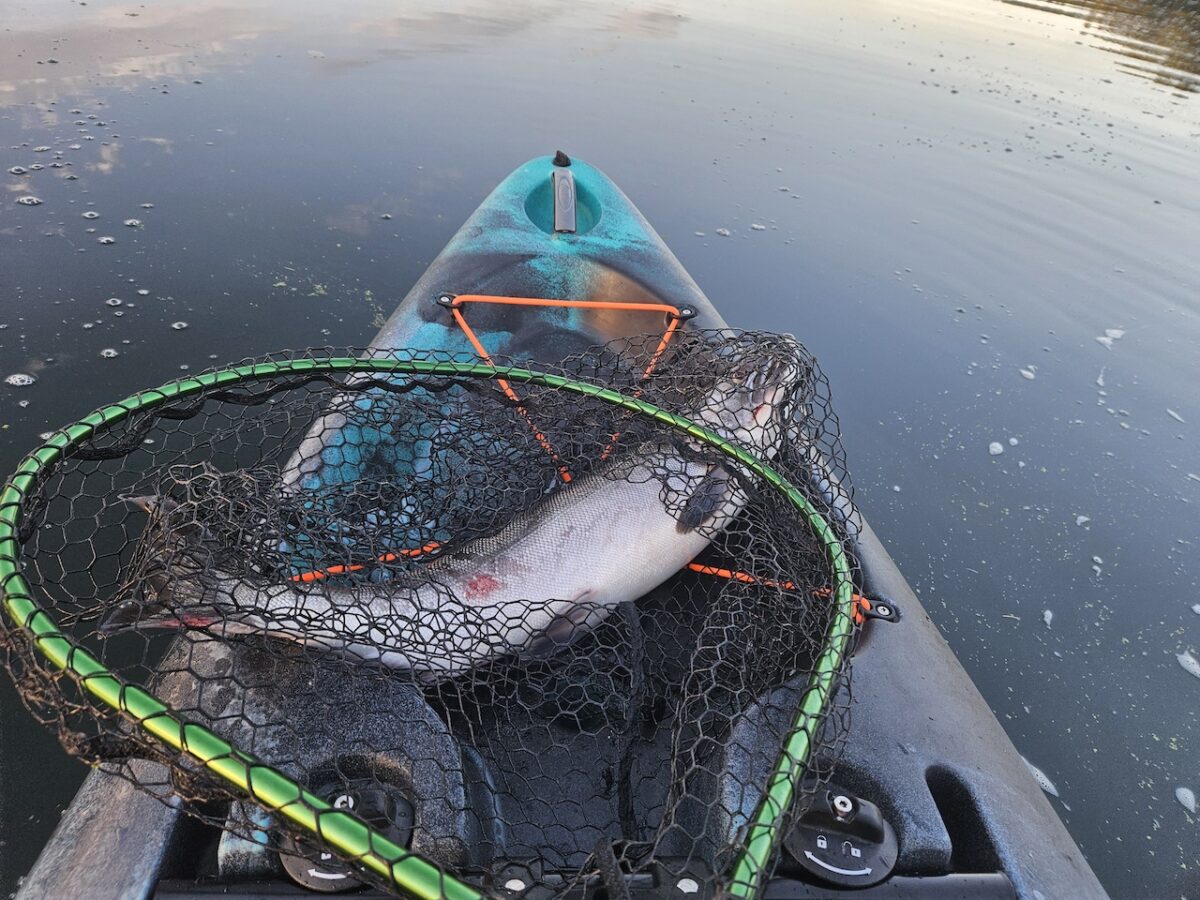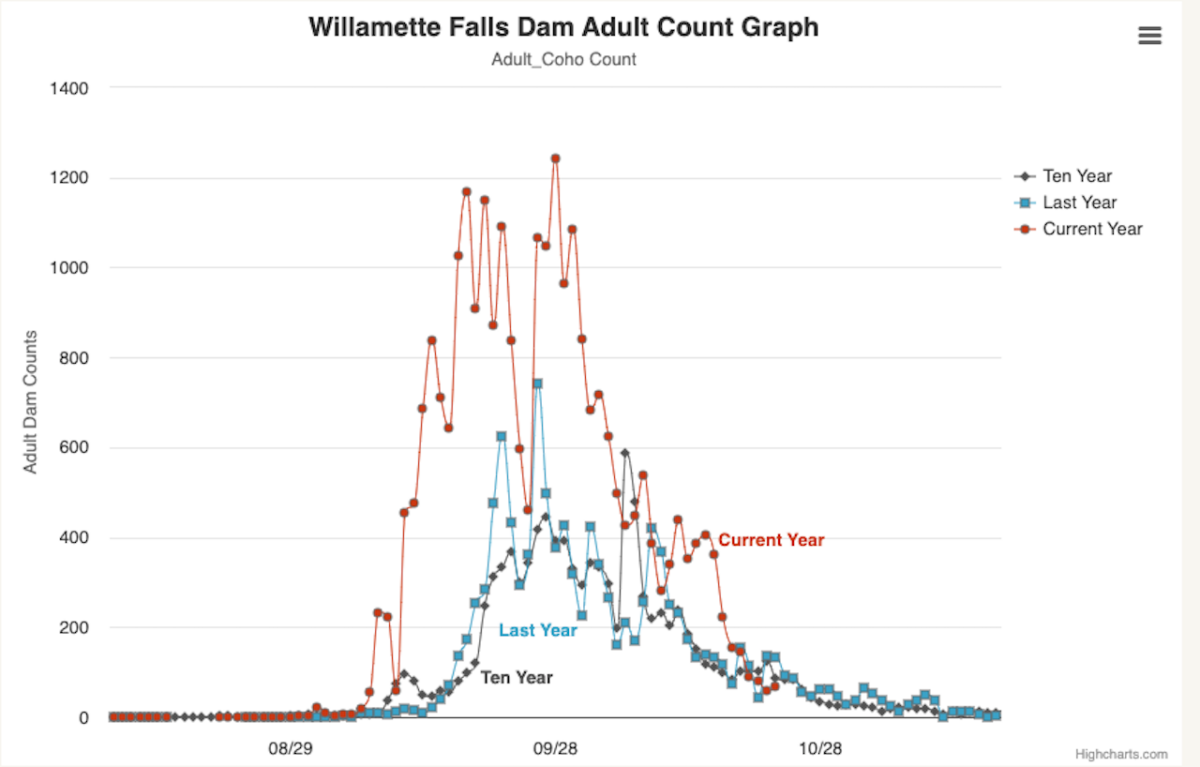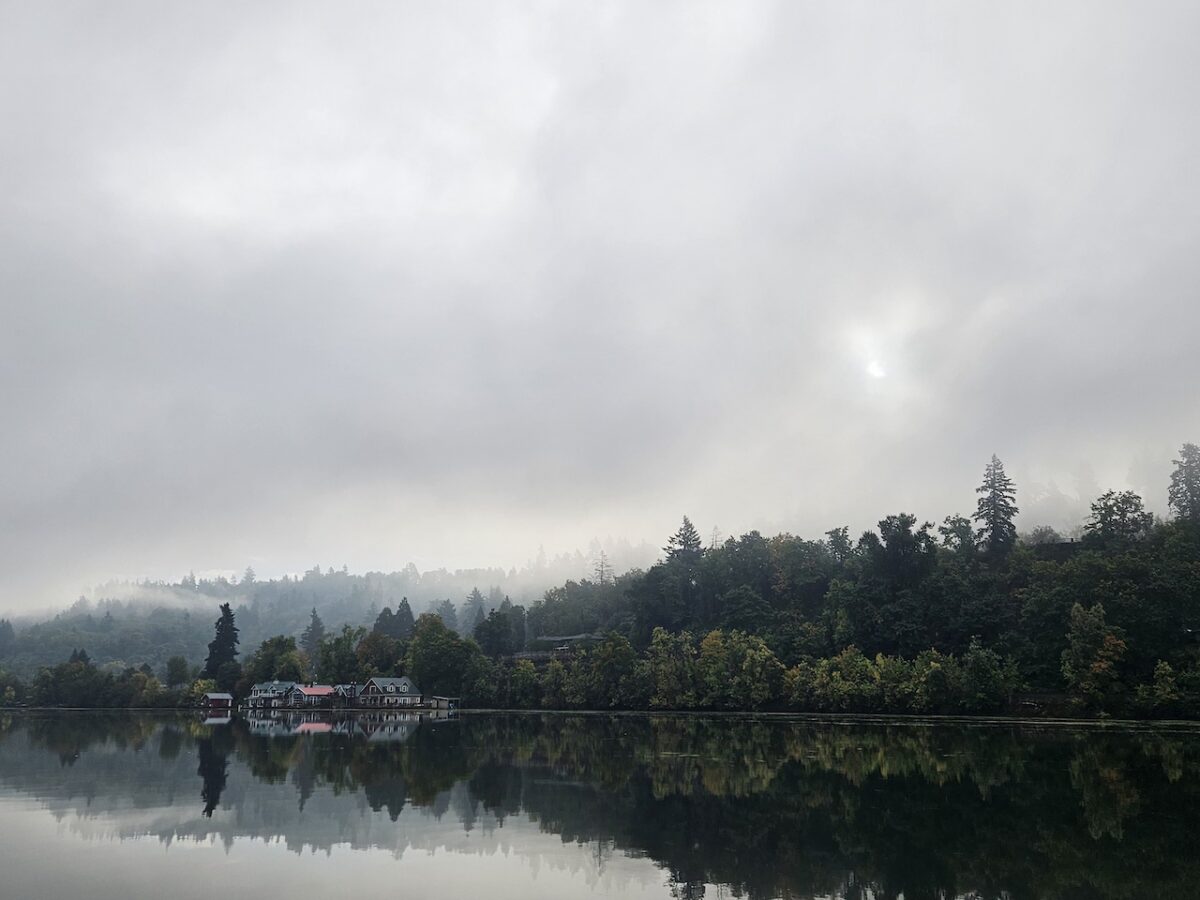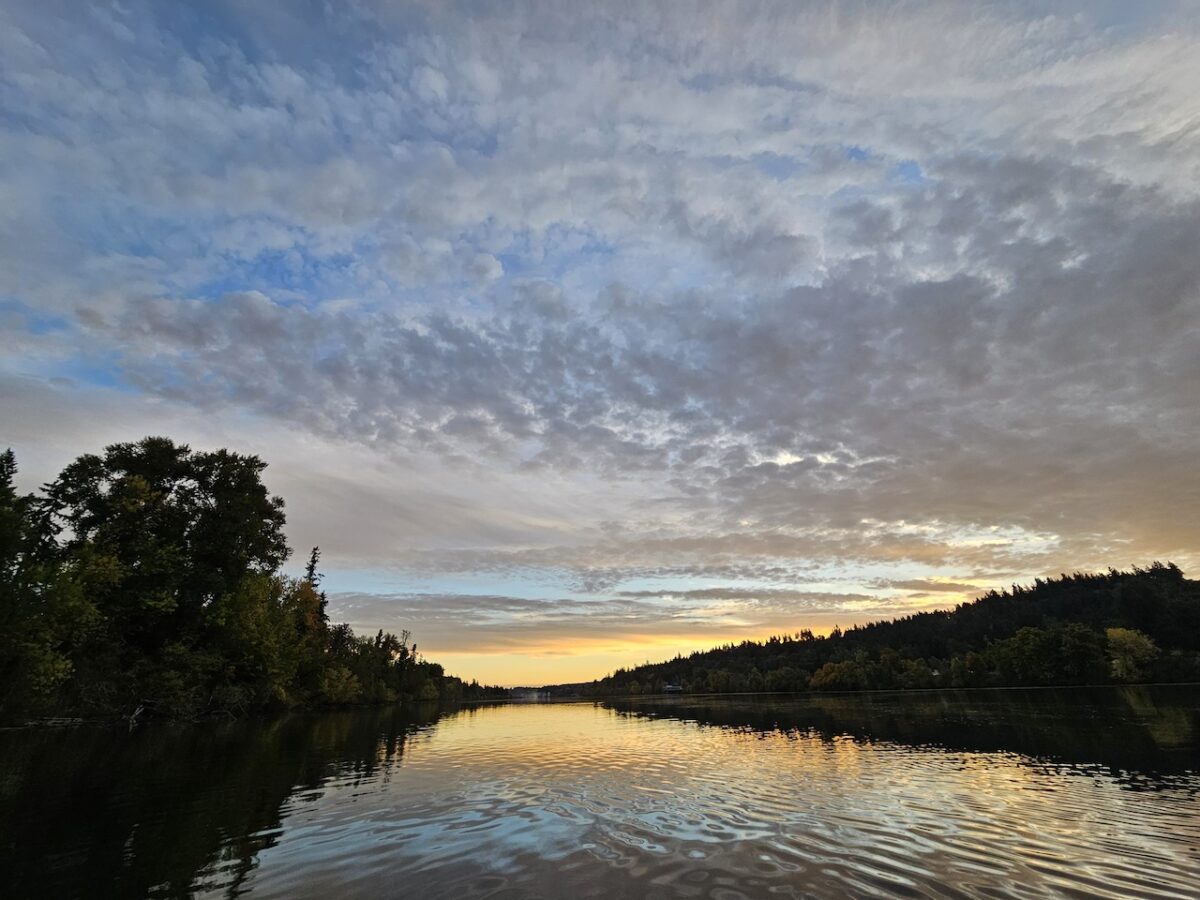
Upper Willamette, Clackamas Coho Runs Set New Records
They haven’t been the easiest fish to catch this fall, but coho runs up the Willamette and Clackamas Rivers appear to have set new records, and the salmon are still coming as October draws to a close.

Some 26,599 adults and 10,657 jacks have been counted at Willamette Falls through Tuesday, October 24, more of both age classes than in any single year back to at least 1971, ODFW records show, and while the run is tapering off there, just downstream on the Clackamas the late run of coho will only pad a wild fish tally that has exceeded all other years since 1958 at Portland General Electric’s North Fork Adult Sorting Facility.
“We’re most of the way through the early-run coho return, and have already surpassed the previous record,” said PGE’s Allison Dobscha on Monday. “With 14,607 fish returned to the trap as of earlier today, this year’s early-run return has already exceeded our best-ever coho record for both early- and late-run fish. That previous record of 13,136 coho was set last year. We still expect to see an additional 2,500 to 3,000 late-run coho this year.”
Those early Clackamas fish and nearly all that return above Willamette Falls might be best described as natural-origin coho – progeny of discontinued hatchery releases and probably strays from elsewhere in the lower Willamette – while the late run Dobscha referred to is a native stock.
Hatchery coho also return to the Clack’s Eagle Creek National Fish Hatchery and supervising biologist Jeremiah Civil yesterday said they’ve worked/counted 1,864 fish so far, the spawning channel has another “800ish” fish, the receiving pond is “crammed full” with roughly 3,000, there’s an estimated 1,500 are outside the ladder and he suspects there are probably some out in the mainstem waiting for more rain to bring the creek up.
“As far as this year’s return compared to past years, it’s still a little too early to know if it will be record-breaking like the Clackamas. However, considering that we probably have 5,000 to 7,000 fish back already it’s a pretty good return, as our average is around 5,000,” Civil said.

Unclipped coho must be released on the Clackamas and lower Willamette, but they can be kept above the falls, where the stock is not listed under the Endangered Species Act, and anglers have been trolling, twitching and casting at the mouths of tribs such as the Tualatin, Molalla, Yamhill, Luckiamute and Santiam Rivers and Rickreall Creek since September in hopes of tapping into the relatively huge run. The action, however, has not in general mirrored the impressive count, which peaked well before and much higher than the 10-year average, a Fish Passage Center graph shows.
Still, cross-referencing longterm ODFW catch data with the fish counts, it does appear anglers are getting more and more adept at tapping into the burgeoning run above the falls, with 1,488 kept in 2021 and 984 in 2022, the first and second highest tallies going back to at least 1986. Interestingly, the highest percentages of the run have been caught during relatively low return years, with 2018 yielding 521 fish, or 20.4 percent of the run of 2,557, followed by 2011 and a catch of 443 fish, 13.1 percent of the run of 3,393. Last year’s haul of 984 above the falls represented 8.7 percent of the run of 11,260.
It will be interesting to see what 2023’s catch data shows. Many anglers have been running a mix of 3.5-size spinners, SpinFish or a blade and beads behind 360 flashers, but some are still flatlining Brad’s Wigglers or Storm Wiggle Warts, typically in flame red.
Meanwhile, some of the 2023 run has already cleared the fisheries and is nearing the spawning grounds. Late last week the Confederated Tribes of the Grand Ronde reported the first coho of the year back to Agency Creek, a Yamhill trib west of Willamina.
According to ODFW data, the previous record adult coho count at Willamette Falls was 25,298 in 2009, while the high mark for jacks was 7,157 way back in 1972. Jack numbers, however, don’t appear to mean much for future runs.
“Given the recent track record of coho jack passage over Willamette Falls, it seems that jacks aren’t always a good predictor of run size in the upper Willamette,” said Ben Walczak, ODFW’s North Willamette District fisheries biologist.

A more familiar credit for 2023’s records will be beneficial river and ocean rearing conditions for the runs, and that’s not just germane to silvers.
“On top of these phenomenal coho returns, we’ve also seen the largest return of adult wild spring Chinook [to the Clackamas] since data collection began, as well as the highest number of juvenile fish passing through our bypass system than ever before,” noted PGE’s Dobscha.
Indeed, there’s been a lot of work to boost salmon and steelhead numbers in this watershed east of Portland.
“PGE sees this trifecta of achievements as a culmination of our efforts over the past 17 years to modernize and improve fish passage systems on the Clackamas and invest in habitat alongside many partners in the Clackamas River Basin, as well as more favorable ocean conditions,” the utility spokeswoman added. “More returning adults spawning upstream leads to larger generations of young fish headed to the ocean to start the cycle over again.”
Good coho runs are being seen throughout the Northwest this year, including in Puget Sound and the Columbia-Snake system.
“When coho or other anadromous salmonids numbers are up (or down), region-wide ocean conditions tend to play a major role,” said Walczak.

Some 80 million young hatchery coho were released widely into the Willamette above the falls from the 1950s to 1996, but today’s population primarily occurs in the north half of the system.
“To date, recolonization by coho in the upper Willamette has been focused on the lower tributaries,” said Walczak. “Parents of this year’s returning adults likely spawned in the Molalla, Yamhill and Tualatin. Coho have not really hit the Santiams or McKenzie, where management of high-head dams and reservoirs dominate the systems.”
As the population began to build following 2009’s big run, there was a bit of concern about the potential for competition between the young coho and juvenile ESA-listed spring Chinook and winter steelhead. All three species require extended in-river rearing time.
“As with any big invasion, there are certainly tradeoffs. Coho are probably less of an ecological concern than, say, smallmouth bass in the Willamette, but adding a salmon species does present some risks to the native Chinook and steelhead,” said University of Idaho researcher Matt Keefer who wrote a 2018 paper looking into the colonization of the upper basin. “Particularly true given the precarious status of the latter.”
Asked if ODFW had any worries about competition, Walczak replied, “No concerns currently.”
One other note on the numbers: ODFW data shows that this is the first year the falls adult coho count has exceeded the adult spring Chinook tally, which ended up at 23,422.
It’s unclear how much larger the coho run might become, but as the ODFW biologist noted, “there’s thousands of miles of stream habitat that have different levels of access and suitability.”
Another question anglers might have this year is, given the big wild return back to the Clackamas, what are the odds of opening those fish for retention in the tributary and Willamette below the falls? Walczak reminded that coho in those waters are federally protected.
“So there are numerous regulatory hurdles to overcome for wild coho retention to become a reality. A thoughtful, careful approach that includes buy-in from federal and state managers with public input could make this a reality, if the numbers continue their current trajectory,” Walczak said.
Coho runs, just like all salmon and steelhead, are cyclical. They’re on a high right now, inevitably there will be a decline, but long term, the trajectory for upper Willamette and Clackamas coho is looking up.
Editor’s note: In the second paragraph, Portland General Electric’s Clackamas coho count start year has been updated from “at least 2000,” which was based on the utility’s online table, to 1958, per a subsequent message from spokeswoman Allison Dobscha, making 2023’s return all the more impressive!

